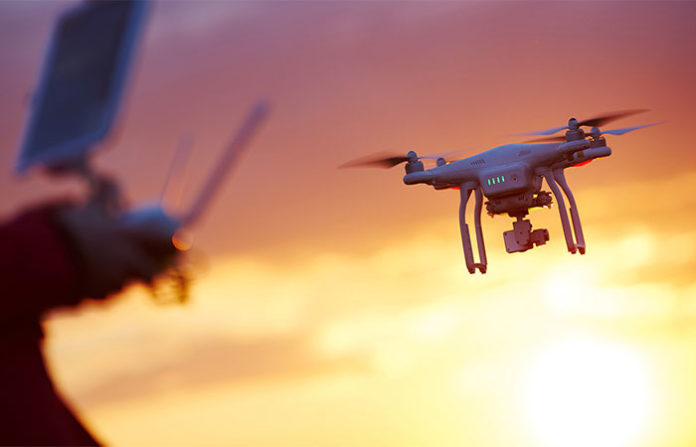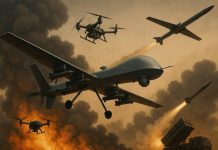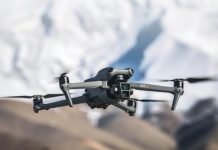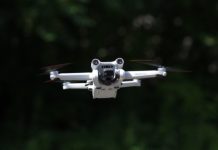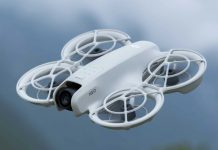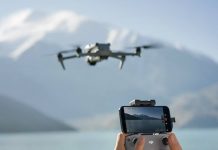Drones, also known as Unmanned Aerial Vehicles (UAVs), Remotely Piloted Vehicles (RPVs), or Remotely Operated Aircraft (ROAs), play a prominent role in military operations, including counterterrorism and counterinsurgency, transforming warfare similar to the gunpowder revolution.
They can engage in tasks that are inherently less suited to manned aircraft. Their low cost makes them ideal and expendable for politically sensitive and highly dangerous missions.
There are three types of drones being used in military operations today: strategic, operational, and tactical. Strategic drones in military operations specialize in long-range reconnaissance over hostile territory. They cruise at 20,000 meters above sea level for 40 hours and travel 3,000 nautical miles.
Operational drones fly at 7,500 to 15,000 meters and are deployed for both reconnaissance and attack purposes. Tactical drones are low altitude, short-range aircraft (20 miles or less) that are remotely piloted or preprogrammed to fly autonomously for crowd control and border surveillance. Most other types of drones are used for intelligence gathering.
In short, drones contribute to several different missions in the armed forces. For instance,
- Target and decoy: In these missions, drones are usually used in training for anti-aircraft. They simulate an enemy aircraft or missile.
- Tactical reconnaissance: Large, high speed and jet-powered UAVs with radio control are often used for reconnaissance to take pictures of predesignated targets and provide battlefield intelligence. They are launched from airplanes and recovered by parachute, and carry the day-night camera and other equipment.
- Combat: Combat drones provide attacking capabilities in high-risk missions. They carry standard air-to-ground, directed energy, and air-to-air weapons.
- Logistics: delivering vital supplies to front line troops in combat such as emergency food and ammunition in a short amount of time, especially in challenging environments – often dubbed ‘the last mile.’
Pros of armed drones
Drones have a leading role in counterterrorism/counterinsurgency for several reasons. First, their low noise makes them less likely to detect their presence. Second, drones can hover over an area longer than any other aircraft. Lastly, they can fly low, not exposing themselves to enemy fire, to verify the nature of their targets. These advantages ensure maximum impact of their mission and reduce the prospects of collateral damage among the local non-combatant population.
- Drones are significantly cheaper to build than planes. They have lower maintenance costs and are very cost-effective in training plane pilots and maintenance staff.
- Drones require fewer troops to be deployed overseas. This reduces personnel involvement in high-risk tactical missions.
- Using Precision Guided Munitions with drones reduces civilian casualties, compared to more traditional airstrikes from bombers and fighter jets.
- Drones can constantly surveil the terrorists’ movements, their training, and operations from the sky. This exercises severe pressure on terrorist organizations.
- Drones have demonstrated themselves to be very efficient in hitting well-defended, well-hidden targets, or high-value targets, such as senior leaders of terrorist organizations.
- Drones provide great flexibility to swiftly respond to terrorist attacks or newly discovered intelligence.
- They can also be operated from very far away, and many of their functions automatically. This helps reduce the possibility of human mistakes during an operation.
Cons of military drones
Despite the advantages, technical limitations, and advancements in competing technologies, such as air defense systems, they shall circumscribe drones’ military role. Thus, even though drones are an integral part of warfare, they cannot fully replace manned aircraft but will complement them.
Besides, drones are yet to prove themselves better than manned aircraft based on common performance standards. For instance, drones are effective only in attack roles when operating against targets with no air defense capabilities.
Unlike fighter jet pilots, drone operators cannot detect threats to the safety of their aircraft. Surface-to-air missiles, therefore, pose a much more significant threat to drones than to other forms of military aviation. The vulnerability of drones to ground fire can become a debilitating factor if greater dependence is placed on drones in warfighting.
Although drones’ significant advantage is their low acquisition cost relative to manned aircraft, heavy losses to enemy fire will drive the overall cost of drone operations beyond sustainable levels.
Here are some of the cons of using armed drones in military use.
- It is difficult to evaluate the effectiveness of drone strikes. For instance, death tolls are difficult to calculate in targets that are in inapproachable or remote areas.
- Drone strikes prevent terrorists from being captured, who can otherwise be interrogated to provide valuable intelligence.
- Drone strikes can cause collateral damages in many targets in residential areas, increasing the chances of civilian casualties.
- Eliminating high-value targets does not necessarily mean an end to terrorist organizations. Moreover, these attacks can be used as propaganda and turn high profile targets into martyrs.
- In a war against terrorism, defining who is a militant or simply a sympathizer is not easy. The decision concerning who becomes a legitimate target of a drone attack is often controversial. Some sources claim that around 80-90% of the people killed by drone strikes are civilians.
- Drone strikes can destabilize the security if one undermines a country’s security and military operations in which the strike is made.
- Sometimes strikes occur secretively in countries that are not officially at war. The use of drones to hit military targets when war has not been declared is considered illegal by most experts. This raises serious ethical and political concerns regarding transparency, sovereignty, and the legitimacy of hostile actions.

